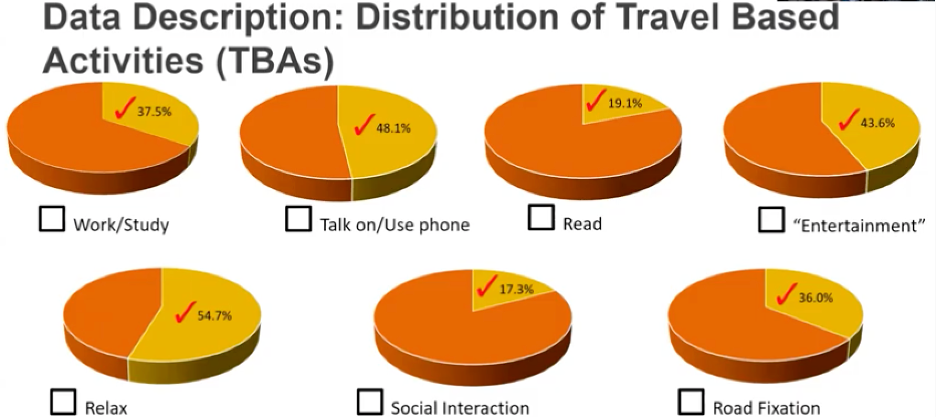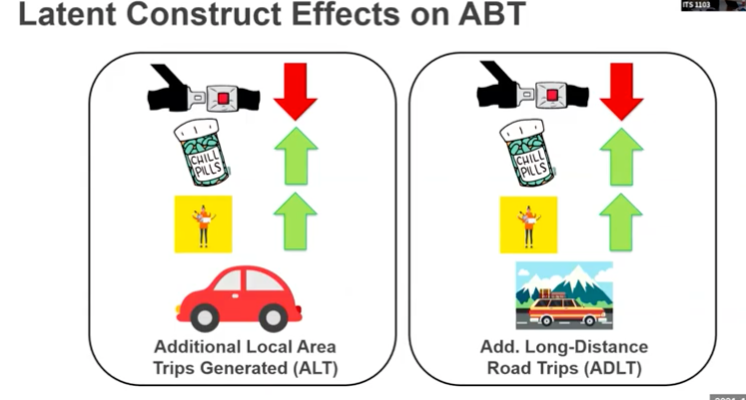News | ITS-Davis, PSR Host Seminar on How Might People Spend Time When Traveling in an Automated Vehicle
Stop the VideoNews

ITS-Davis, PSR Host Seminar on How Might People Spend Time When Traveling in an Automated Vehicle
Friday, December 24, 2021
by Hayley Rundle, USC Master of Urban Planning
On November 19th, the UC Davis Institute of Transportation Studies (ITS-Davis) in partnership with the Pacific Southwest Region University Transportation Center (PSR) hosted Professor Chandra Bhat for a seminar on autonomous vehicle impacts. Titled “How Might People Spend Time When Traveling in a Fully Automated Vehicle, and What Effect Might it Have on the Intensity of Travel,” the seminar featured research from Dr. Chandra Bhat and his team. Dr. Bhat is a professor in the Department of Civil, Architectural, and Environmental Engineering at the University of Texas at Austin. Dr. Bhat is the Director of the Data-Supported Transportation Operations and Planning (D-STOP) Tier 1 USDOT University Transportation Center and the Joe J. King Chair in Engineering. Dr. Bhat is an expert in the area of transportation and urban policy design, with far reaching implications for public health, energy dependence, greenhouse gas emissions, and societal quality of life.
The seminar was the last event hosted by ITS-Davis for the fall quarter and drew an enthusiastic audience from Texas and California. The session began with a formal presentation and ended with a discussion of the audience’s questions.
Dr. Bhat began the presentation by diving into the benefits of autonomous vehicles (AVs), which have been abuzz in the worlds of transportation, technology, and media. An autonomous vehicle is a self-driving car that is capable of sensing its environment and moving safely with little or no human impact. AVs have the potential to improve road capacity and reduce the amount of human error that is associated with regular vehicles, which can often lead to accidents. Dr. Bhat’s research, and the focus of this seminar, is centered around the benefits AVs can provide to people in the car. AVs have the ability to rechannel the time used for driving tasks to other activities, and research suggests that people value the time they spend traveling; therefore, being able to travel without driving would be a benefit.
Dr. Bhat then delved deeper into the value of time travel savings (VTTS) which is based upon effectively using travel time to release time elsewhere to pursue other enjoyable activities. Some simulation studies assume VTTS reduction of 50-100% relative to current car driver VTTS. However, other studies caution against the use of such substantial VTTS reductions, and suggest that the level of VTTS reduction associated with AVs may be more modest in the range of 25-30%..
The study linked to this research focused on the types of activities that could be pursued during travel which are considered to be part of the larger daily activity space-time continuum. The study investigated if and by how much the ability to pursue travel-based activities (TBAs) affect activity-based travel (ABT). The study also identified four latent constructs that may impact what activities people might undertake in an AV. The four latent constructs are below:
- Technology savviness: a measure of how educated, well-informed, and experienced a respondent is with technology
- Safety Concern: AV technology-related safety concern, which has been well established as an important factor in an individual’s adoption of an AV.
- Being Chill: Represents an individual’s ease and response when traveling.
- Interest in Productive Travel Time: An individual’s perception toward productive use of travel time.
As part of the research, Dr. Bhat and his team conducted a survey to analyze how people would spend their time if traveling in an AV. The survey was conducted in the Austin metropolitan area in Texas and had 970 respondents. The survey respondents were 65% female and 35% male, and largely represented young people. For this reason, this was not a representative sample but still provided insight into people’s perceptions and feelings toward AVs and how they could impact time savings.
To assess TBAs—i.e., what activities people would undertake while traveling in an AV—the survey asked, “Suppose you are traveling in an AV, which of the following would you do in the vehicles during the trip? Select up to 3 activities.” The activities offered were work or study, talk on phone/send or read text messages/teleconference, read, sleep, watch movies/TV/other entertainment, play games, eat and drink, interact with other passengers, enjoy the scenery, and watch the road even though I would not be driving. From the research side, the activities offered were split up in ‘chill activities’ and ‘other activities.’ Chill activities included talk on/use phone, read, entertainment, relax, and social interaction. Other activities included work/study and road fixation. The survey results found that the top three activities were relax, talk on/use phone, and entertainment. Never were work/study and watch the road chosen together.

Distribution of TBAs chosen by survey respondents.
To assess ABT—i.e., what activities people would travel to in an AV—the survey asked, “How likely are you to make additional local trips (ALT) and additional long-distance trips (ALDT)?” The question used a simple ordinal measure of very unlikely to likely. The survey results found that people are generally more likely to make additional long-distance trips than additional local trips.
The results of the survey responses were also organized into the four different latent constructs described above. The latent construct results were not surprising when considering the demographics. For example, women are known to be more concerned with safety and older individuals would prefer to drive a car than use an AVs, which were reflected in the survey responses. Latent construct effects on TBAs found that a “chill person” was more likely to engage in a non-work chill travel-based activity such as reading, watching TV, or using their phone. A safety concerned individual would be unlikely to participate in work as well as chill TBAs (except talk/text), and are more likely to be road-fixated. Lastly, results from the survey responses found that “productive use of time” is not necessarily tied to activities such as work/study, but is also tied to relaxation and social interaction.
Regarding ABT tied to AVs, the responses found that “chill people” were likely to increase additional local trips and additional long-distance trips when traveling in an AV. People with an interest in productive travel time were also likely to increase additional local trips and additional long-distance trips when traveling in an AV. People that were not likely to make additional trips in the AV were inherently road fixated and are likely concerned about the safety implications of traveling in an AV.

Visual graphic of the increase/decrease in ALTs and ADLTs based upon latent construct.
Dr. Bhat then shared his overall conclusions from the research. The study found that activities people would pursue within an AV depend on certain characteristics, and across-the-board and rather ad hoc VTTS reduction assumptions should not be made. For example, a single parent may not be interested in productive use of travel time because they may have things they need to do that cannot be done in a vehicle. Also, the possibility of pursuing work/study activities in an AV itself may create stress in individuals, and may actually make travel in an AV even less enjoyable for some individuals than the current human-driven environment. Additionally, TBAs and ABT should be considered as a joint package, before examining how TBAs may affect ABT. TBAs should also be considered in a broader context of emotional well-being and quality of life.
Dr. Bhat wrapped up the presentation by offering his suggestions for future studies regarding the impact of AVs. Dr. Bhat hopes to create a richer virtual reality-based presentation mechanism featuring vehicular design possibilities in order to elicit more accurate travel-based activity preferences. Knowing the size, shape, and design of an AV may impact what activities people undertake while traveling.
If you would like to watch a recording of the seminar, please click here.
About the Author:
Hayley Rundle is a second-year Master of Urban Planning student at the USC Price School of Public Policy, concentrating in Mobility and Transportation Planning. Hayley is interested in sustainable transportation planning to improve environmental quality, equity, and mobility for all. Hayley serves as the team leader for the METRANS Industry Engagement and contributes to the Student Research Team, summarizing cutting edge transportation research projects and findings for the METRANS Fast Facts for Students series.
News Archive
- December (1)
- November (6)
- October (4)
- September (2)
- August (3)
- July (4)
- June (3)
- May (7)
- April (8)
- March (11)
- February (8)
- January (7)
- December (7)
- November (8)
- October (11)
- September (11)
- August (4)
- July (10)
- June (9)
- May (2)
- April (12)
- March (8)
- February (7)
- January (11)
- December (11)
- November (5)
- October (16)
- September (7)
- August (5)
- July (13)
- June (5)
- May (5)
- April (7)
- March (5)
- February (3)
- January (4)
- December (4)
- November (5)
- October (5)
- September (4)
- August (4)
- July (6)
- June (8)
- May (4)
- April (6)
- March (6)
- February (7)
- January (7)
- December (8)
- November (8)
- October (8)
- September (15)
- August (5)
- July (6)
- June (7)
- May (5)
- April (8)
- March (7)
- February (10)
- January (12)















